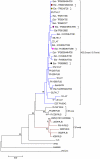Eliminating rabies in Estonia
- PMID: 22393461
- PMCID: PMC3289618
- DOI: 10.1371/journal.pntd.0001535
Eliminating rabies in Estonia
Abstract
The compulsory vaccination of pets, the recommended vaccination of farm animals in grazing areas and the extermination of stray animals did not succeed in eliminating rabies in Estonia because the virus was maintained in two main wildlife reservoirs, foxes and raccoon dogs. These two species became a priority target therefore in order to control rabies. Supported by the European Community, successive oral vaccination (OV) campaigns were conducted twice a year using Rabigen® SAG2 baits, beginning in autumn 2005 in North Estonia. They were then extended to the whole territory from spring 2006. Following the vaccination campaigns, the incidence of rabies cases dramatically decreased, with 266 cases in 2005, 114 in 2006, four in 2007 and three in 2008. Since March 2008, no rabies cases have been detected in Estonia other than three cases reported in summer 2009 and one case in January 2011, all in areas close to the South-Eastern border with Russia. The bait uptake was satisfactory, with tetracycline positivity rates ranging from 85% to 93% in foxes and from 82% to 88% in raccoon dogs. Immunisation rates evaluated by ELISA ranged from 34% to 55% in foxes and from 38% to 55% in raccoon dogs. The rabies situation in Estonia was compared to that of the other two Baltic States, Latvia and Lithuania. Despite regular OV campaigns conducted throughout their territory since 2006, and an improvement in the epidemiological situation, rabies has still not been eradicated in these countries. An analysis of the number of baits distributed and the funding allocated by the European Commission showed that the strategy for rabies control is more cost-effective in Estonia than in Latvia and Lithuania.
Conflict of interest statement
The authors have declared that no competing interests exist.
Figures






References
-
- Niin E, Laine M, Guiot AL, Demerson JM, Cliquet F. Rabies in Estonia: situation before and after the first campaigns of oral vaccination of wildlife with SAG2 vaccine bait. Vaccine. 2008;26:3556–3565. - PubMed
-
- Anonyme Communicable disease statistics in Estonia. Part 7: 2000. Health Protection Inspectorate, Tallinn. 2000:32–33.
-
- Bugnon P, Breitenmoser U, Peterhans E, Zanoni R. Efficacy of oral vaccination in the final stage of fox rabies elimination in Switzerland. J Vet Med B Infect Dis Vet Public Health. 2004;51:433–437. - PubMed
-
- Aubert MFA, Cliquet F, Smak JA, Brochier B, Schon J, et al. Rabies in France, the Netherlands, Belgium, Luxembourg and Switzerland. In: King A, Fooks AR, Aubert M, Wandeler AI, editors. Historical perspective of rabies in Europe and the Mediterranean Basin. Paris: O.I.E; 2004. pp. 129–145.
-
- Capello K, Mulatti P, Comin A, Gagliazzao L, Guberti V, et al. Impact of emergency oral rabies vaccination of foxes in northeastern Italy, 28 December 2009–20 January 2010: preliminary evaluation. Eurosurveillance. 2010;15:1–4. - PubMed
MeSH terms
Substances
Associated data
- Actions
- Actions
- Actions
- Actions
- Actions
- Actions
- Actions
- Actions
- Actions
- Actions
- Actions
- Actions
- Actions
- Actions
- Actions
- Actions
- Actions
- Actions
LinkOut - more resources
Full Text Sources
Medical

